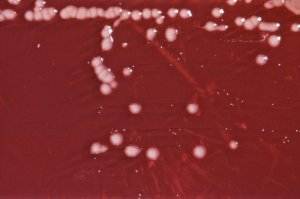I – GENERAL CHARACTERISTICS:
A – Definition:
Gram-negative bacilli, by a polar mobile ciliature rarely still, non-spore forming.
Chemo-organotrophic bacteria with a strictly respiratory metabolism with terminal electron acceptor such as oxygen aerobically and for some species anaerobically with nitrate synthesis of nitrate reductase (“breathing nitrates”).
Oxidative or inactive in the trial of Hugh and Leifson.
Almost always oxidase (+) that is to say having most complete cytochrome chain including cytochrome c and cytochrome C oxidase.
Characterized by the plurality of hydrocarbon substrates used as a carbon and energy source.
Bacteria widespread in nature, characterized by their resistance to antibiotics and antiseptics.
G + C% between 58 and 70 (fairly homogeneous).

B – Morphology and structure:
Sticks rights and for 0.5 to 1.3 μ m.
Structure of the Gram-negative bacilli, no significant difference in the peptidoglycan of the wall structure.
Vivid mobility aerobically. Polar ciliature: monotriche – multitriche.
For multitriches species type of cilia can be established statistically determining the flagellar index. It may vary according to culture conditions.
Some strains and P. mallei are immobile and aciliées.
C – Growth and nutrition:
Many species and strains of Pseudomonas did not grow at 37 ° C while the temperature of 30 ° C is suitable for all, pathogens and saprophytes.
Culture is easy on complex medium with or without pigment production. They are able to grow on synthetic mineral media with a single source of carbon: acetate, pyruvate. These properties are used to highlight appropriate auxotrophies for identification.
The auxotrophy, or growth factor requirements, is characteristic for:
X. (. P) maltophilia methionine or cystine.
P. diminuta – P. vesicularis: pantothenate, biotin, cyanocobalamin.
Since the Base article Stanier Palleroni, Doudoroff (/. Gen. Microbiol. 1966, 43, 159-271), the taxonomic study of the species is possible according to the study of carbon substrates used as a source energy for growth.
This is auxanogramme.
D – Pigments developed by Pseudomonas:
The two most common pigments and features are pyocyanin and pyoverdin.
Ds are soluble in the culture media, and can color them.
Pigmented species are for example:
– P. aeruginosa: Pyocyanin + pyoverdine, it has one or the other or both, but can be lost through mutation. There are varieties or melanogenic erythrogenic producing a black pigment or a red pigment.
– P. fluorescens, P. putida, P.syringae and P. cichorii produce pyoverdine but some strains are sometimes apigmentées.
– P. aureofaciens: orange yellow pigment or purple.
E – physiological characters:
These bacteria have a short life span in culture even at 4 ° C.
– All possible conservation modes are offered: lyophilisation, sterile distilled water with ordinary temperature culture Cove 18 ° C (plant pathogenic Pseudomonas) slant with paraffin oil surface with a soft agar, screw tube as for Enterobacteriaceae freezing.
– Lytic properties: P. aeruginosa – Late autolysis (4-5 days) or early (iridescent spots with a metallic sheen on agar).
– Sensitivity to lyrical agents: several Pseudomonas species are lysogens and bacteriocinogenic
-P. aeruginosa: probably 100% + strains lysogenic many pyocines.
– P. fluorescens: frequent lysogénie; fluocines.
– P. stutzeri: lysogénie little studied.
These characters are of epidemiological interest.
F – Metabolism:
Pseudomonas is the model of oxidizing bacteria or say oxybiontiques. The return to growth is strictly dependent on the concentration of oxygen dissolved So agitation.
– The enzymes of glycolysis (fermentative Embden-Meyerhof) are absent.
– The complete oxidation of glucose is carried out under aerobic conditions in the shunt of the hexose monophosphate pathway or Warburg-Dickens Horecker through 6 P-gluconate, the way of 2-keto-3 désoxygluconate (route of Entner-Doudoroff resulting pyruvate fueling the Krebs cycle). Hence the interest of the middle of Hugh and Leifson (acidification in the tube without vaseline aerobic).
Paradoxically for Pseudomonas certain strict aerobic organisms can draw their energy from an anaerobic catabolic reaction by hydrolysis of arginine = System of arginine dihydrolase (ADH), which constitutes:
This system has strengthened the hypothesis that the mobility due to flagellar movement is related to ATP. It is demonstrated in Pseudomonas fluorescens, still under anaerobic conditions but which becomes mobile in the presence of arginine.
This reaction taxonomic significance. There is an alkalinization of the medium giving a purple color characteristic (Middle Moeller).
The attack by oxidation of carbohydrates can be the basis for the identification of Pseudomonas species but all do not give products acids from sugars such as glucose; some have an alkalizing or are inactive.
II – CLASSIFICATION:
The genus Pseudomonas is a genus bloated with 160 species recorded in 1957. In reality, many of these strains are only poorly known and whose type species can not be defined nomenspecies. Two hundred and sixty five species were identified, but the 1974 edition of Bergey’s Manual was holding 29 species including 13 medical interest. The new 1984 edition of Bergey’s Manual retains 30 main species.
Family Pseudomonadaceae currently has 5 genera Pseudomonas, Comamonas, Frateuria, Xanthomonas andZoogloea.
A number of genetic studies were performed and allowed to divide the genus Pseudomonas in 5 different genetic affinity groups: Groups homologies based on DNA hybridization rRNA and DNA-DNA.
– Genomics Group 1 Group fluorescens + group + stutzeri alcaligenes group
– Genomics Group II Group pseudomallei + cepacia
– Genomics Group III Group acidovorans
– Genomics Group IV Group diminuta-vesicularis
– Genomics Group V Group maltophilia (Xanthomonas)
We must be aware, and this is true for any widespread bacteria in nature, the diagnosis of a strain of Pseudomonasis often done by a combination of several characters. These germs are ubiquitous numerous biotypes that tend to deviate from the type species.


You must be logged in to post a comment.